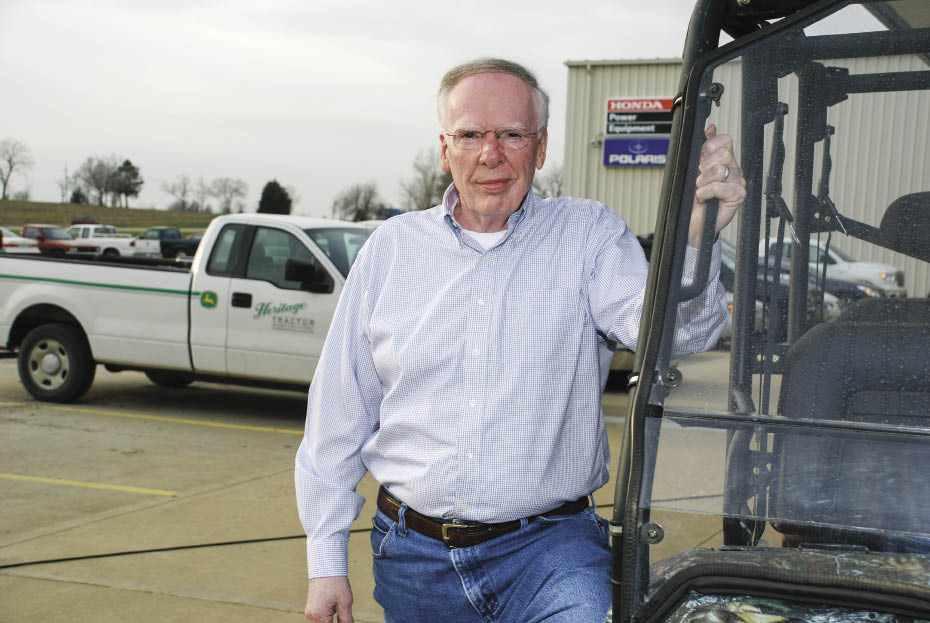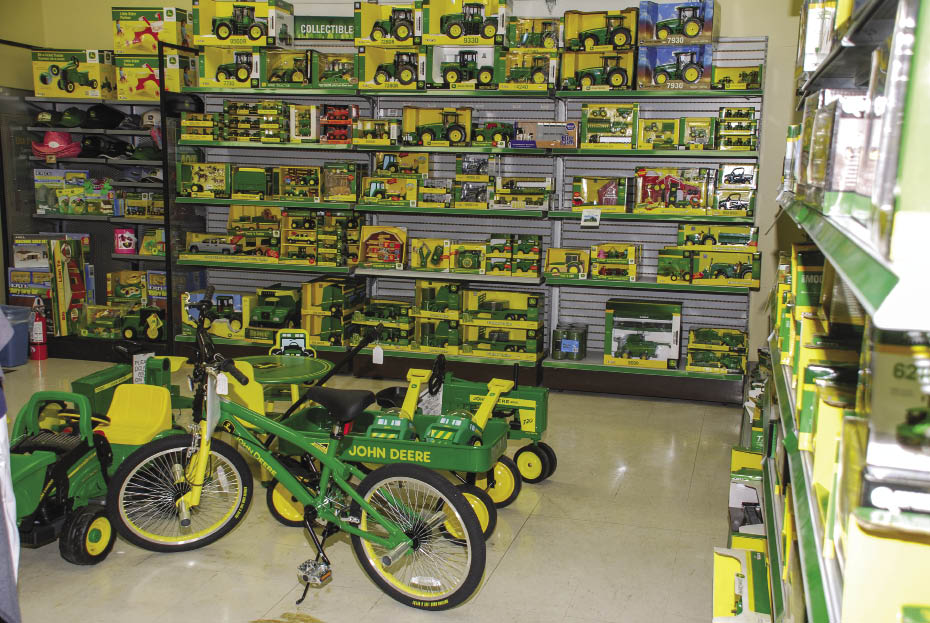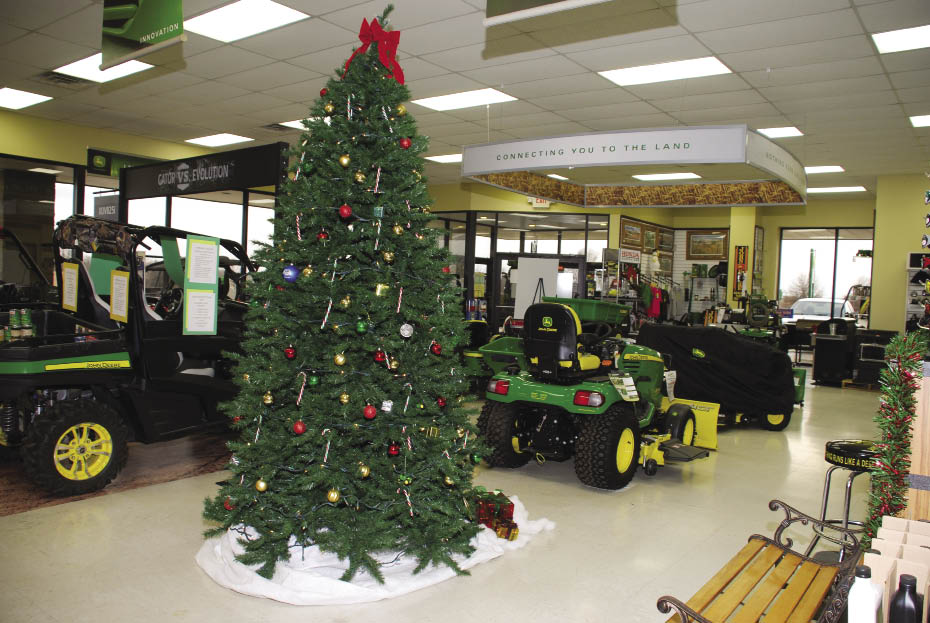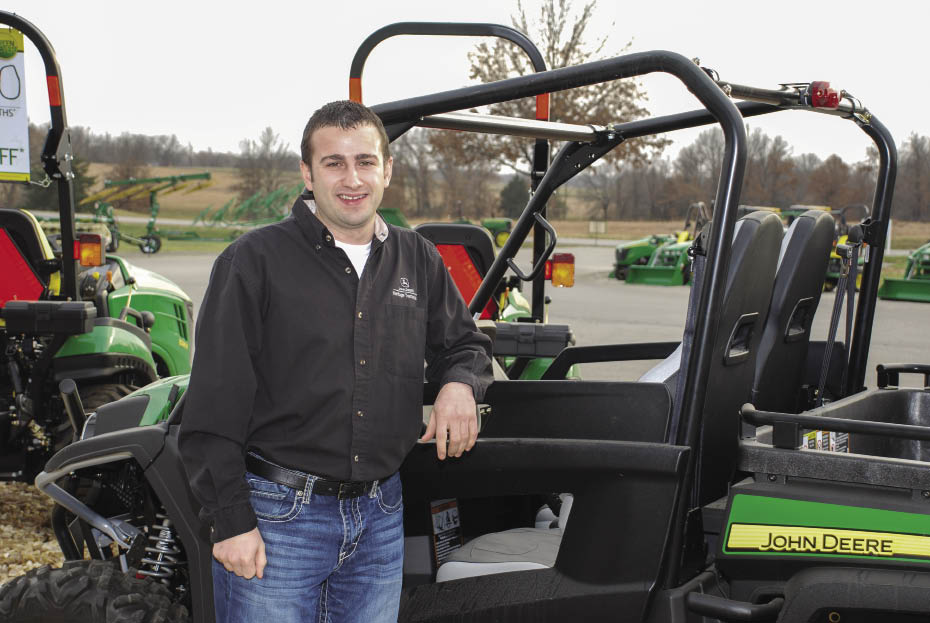Heritage Tractor set up shop 14 years ago in Baldwin City, Kan. The location was not yet served by a John Deere dealership and was perfect for reaching both the ag and rural lifestyle market. It’s in the middle of farm country and less than 50 miles from the metropolitan areas of Lawrence, Kan., and Kansas City, Mo.
“Not too many dealers have a location as close as we are to metro areas with a significant presence of large property owners. We can tap into the market potential of Kansas City, which continues to spread south,” says Mike Fraser, Heritage Tractor’s executive vice president.
The dealership has since grown to include locations in Atchison, Lawrence, Topeka and Paola, Kan., and Clinton and Harrisonville, Mo.
Location is a factor in their success, but a prime spot on the map doesn’t matter when a two-year drought stalls purchases of new equipment.
Fraser along with Derick McGhee, Heritage Tractor marketing manager, share how the dealership coped with the drought this past summer and fall and what they are doing to boost sales over the winter.
Building the Plan
Heritage’s tagline is “Legendary Products. Extraordinary Customer Service. That’s our Heritage.” To make that tagline real, Fraser and company owners, the Dummermuth and Wagner families, commit to annual strategic planning and measuring results year-round.
Heritage Tractor,
Baldwin City, Kan.
Founded: 1998, with stores now in Atchison, Lawrence, Topeka and Paola, Kan., and Clinton and Harrisonville, Mo.
Location: On a main highway on the outskirts of Baldwin City, a town of about 4,500, and near the major metro areas of Lawrence, Kan., and Kansas City, Mo.
Lines: John Deere, Frontier, Honda, Land Pride, Schaben Industries, Stihl and Polaris
Challenge and Solution: Droughts in 2011 and 2012 cut equipment sales. Heritage met the challenge by adding new lines, such as John Deere Landscapes and Honda walk-behind mowers and generators. They boosted retail sales with online advertising.
“Strategic thinking is creating the vision and strategic planning is execution, to make your dreams come alive. If you don’t have a plan, then you don’t know if you won and on pace to achieving your long-term goals,” Fraser says. He spent 30 years as Hallmark’s vice president of sales and then several years as a business consultant.
“With anything worth doing in business, you have to keep score. You have to figure out if you are winning or losing against a defined thought process.”
Fraser develops a two-year and a five-year strategic plan each year in November and December. The plan, which totals about 20 pages when complete, includes a financial analysis, including monthly, year-to-date and rolling 12-year reports. The numbers are complemented with a review of the dealership’s strengths, weaknesses, opportunities and threats.
“We do a five-year ‘horizonal’ view of the business and look at what we want the business to look like. We look at key metrics such as sales and profitability. We look at critical things we need to do to achieve our goals. Those might be people, financial investments, or physical locations. And, we look at threats, which might be internal or external. Internal threats are ‘Do we have the right people’ or ‘Do we need additional expertise?’ Or, it might be investments. External threats could be weather or the federal government,” Fraser says.

Two years of drought stalled equipment sales for many dealerships including Heritage Tractor, a John Deere dealership with seven locations in Kansas and Missouri. The Heritage team, including Mike Fraser (left), executive vice president, and Derick McGhee (right), marketing manager, adapted by adding equipment lines and boosting online marketing strategies.
Fraser says the plans include goals and measurable objectives for each of the seven stores. The objectives might be different, but the performance measurements are the same, which include equipment sales, parts revenue, service revenue and overall profitability. Each location is briefed on key parts of the plan and its store goals in January.
Fraser compares the planning process to a tractor purchase: “How much horsepower do we need to drive revenue and sales?”
He says a proactive attitude helps the team adjust the plan when necessary.
“We dig deeper and look at actions to get us on track or deal with things out of our control, like the drought. We don’t just take the fork in the road that says ‘Woe is me.’ We take the other fork and look at what we need to do to make the numbers. A month doesn’t make a year. But, if we see a trend, we address it in March or April, not November.”

Mike Fraser, Heritage Tractor’s executive vice president, develops a two-year and five-year strategic plan each year in December. The strategic plan includes a “horizonal” view for the future and measurable yearly goals. The team watches for trends early in the year and adjusts strategies to ensure goals are met.
Taking on New Lines
Heritage put that philosophy into practice recently, when the 2011 drought stretched into 2012.
“When times are tough, you’re either going to be a victim or proactively do things that drive business,” Fraser says.
To help increase its commercial business, the dealership expanded its partnership with John Deere Landscapes this past summer. John Deere Landscapes is a corporate program that sells landscaping equipment and supplies through standalone locations. In its expanded role, Heritage began carrying seed, fertilizer and chemicals in the store.
Dealer Takeaways
• Start the year with short- and long-term strategic plans that include measurable goals. Watch for trends and be open to making changes early in the year.
• Diversify your product offerings to reach weather-proof segments, such as hunters or merchandise shoppers.
• Try new online marketing tactics, such as Groupon or website banner ads, to boost retail sales during the holidays.
• Simple actions, like reducing clutter or repainting, can make your dealership more inviting.
“There will be yards next spring that are going to need attention because of the drought,” says McGhee. “We wanted to make sure our customers have the resources available to hit the ground running.”
The parts department handles sales for the products, using John Deere training materials to learn about application recommendations. The products are generally carried and displayed in spring and fall, so there wasn’t an issue with retail and warehouse space.
To make the expansion successful, Fraser says they became more aggressive sellers and pushed the idea of repairing drought damage. They equipped a special display trailer and hired an intern to head out and meet landscapers — the “cold-calling” approach.
“We reinvented the way we go after that business. We created a different approach to get visibility to the bigger companies,” he says.
They also participated in a John Deere-sponsored landscape event at Kauffman Stadium, home of the Kansas City Royals baseball team. For residential customers, the dealership turned to Facebook and marketing on its website to control marketing costs.
McGhee says the landscape supplies were well-received, but it’s hard to tie the program back to equipment sales. Still, he feels it was worth it.
“Would we have sold the equipment anyway? Maybe or maybe not, but we wanted to be a one-stop supplier and keep customers from getting their needs filled elsewhere,” McGhee says.
Also, this past summer, the dealership turned to Honda to replace a line of push mowers and to begin offering generators and water pumps. The mowers gave them the quality they wanted and the generators added another opportunity for winter sales.
“We’re trying to get every segment,” says McGhee.
The parts department handled sales for these products as well.
“We asked our parts people to become familiar with generators and water pumps. We didn’t feel that supporting those products was the best use of our traditional sales people. The parts people are here in the store and can support those impulse buys.”


Heritage Tractor built its holiday marketing campaigns around the theme, “Christmas toys for everyone.”
The generators and water pumps were promoted in winter service direct mailings to all customers as well as on Facebook and the website. McGhee says he’s still working to improve in-store displays.
“We’re still figuring out the best way to promote these products. Long-term, the Honda line is a great complement to our existing products, similar to what grass seed offers us,” he says.
Heritage also pursued sales opportunities with a market not directly affected by the drought, recreational UTV users, such as hunters. The dealership had been offering the Polaris line and the new Gator RSX became available this summer. It gave the dealership a John Deere alternative for off-road use.
“We’re still in the infant stages of that customer base since it’s a new sector of business for John Deere. It could be very successful for us long term,” says McGhee.
They promoted the new vehicles using banner ads on news websites, through social media and their own website, and through in-store displays.
As with the other new lines, the Gator fills a gap and offers cross-over sales. Those who come in to test the UTVs learn about other products they can use, such as power tools and generators, says McGhee.
Pushing Retail Through Online Marketing
Retail shoppers were another segment not directly affected by the drought. Heritage stepped up its promotions to these customers with new online marketing tactics. Its slogan: “Christmas toys for everyone.”
To gear up interest, McGhee tested Groupon this past summer. Groupon is a localized deal-of-the-day online promotion. Groupon deals are posted for a day and must be redeemed within a certain time frame. Advertisers are required to offer at least a 50% discount. Heritage offered $40 worth of merchandise for $20 and had 88 buyers during the promotion.
McGhee says he’s still evaluating whether the Groupon target demographic (women in the 25-35 age group) could be a potential equipment buyer. However, the promotion did offer a new way to reach customers.
“It was a unique way to be in front of a customer in a way that you wouldn’t think a John Deere dealer would be,” he says. “Any way that I can track and better understand our customers is valuable.”
Closer to the holiday season, McGhee pushed specials and merchandise on Facebook and the website. For instance, Facebook posts listed shopping days until Christmas, offered child and adult gift ideas, and promoted Santa visits at their stores.
All of these efforts had this goal in mind: Get people into the dealership to see the equipment they might need for spring and summer.
“We’re planting a seed for spring, like the winter wheat concept,” McGhee says.
Service specials also bring customers into the store. However, Heritage runs service specials year-round to build and sustain customer relationships. The specials rotate each month and might be for free pick-up and delivery, service discounts or discounts on maintenance kits.
Reducing Marketing Clutter
Fraser says in-store marketing is driven by this question: “How can we impact our customer with visual elements?”
“Retail is retail. We’re no different than Lowe’s or Home Depot or a clothing store. It’s the environment they feel when they come in the store,” Fraser says. He says over the last few years, they reduced the marketing clutter. They stopped posting marketing materials on windows and doors and hanging displays from the ceilings. They focus on the customer’s line of sight with displays from mid-waist up to eye level.
They recently repainted inside to make the stores more inviting, using a more neutral shade of the John Deere yellow. They’ve added outside signage welcoming and thanking customers.

Derick McGhee, Heritage Tractor’s marketing manager, tests new online marketing strategies to encourage different customer segments to visit the dealership. He also develops appealing indoor and outdoor displays to catch the attention of customers.
“How do you attract people? It’s not about the price. It’s about the products and the service they receive after they buy,” Fraser says.
He adds it’s a constant challenge maintaining the right image and fulfilling its promise.
“From the time you enter to the time you leave, we want it to be an extraordinary experience. We want our customers to talk about us to their friends. We want them to know we appreciate their business,” Fraser says.
Sometimes that reinforcement is as simple as making sure customers are informed about specials and thanking them when they leave, he says.
Selling Rural Lifestyle Solutions
For Heritage, the extraordinary experience is rooted in finding solutions.
“Our rural lifestyle customers have more than one need. They may need a mower today and a generator tomorrow. It’s all about ensuring we have the right equipment and having the customer return a second and third time,” McGhee says.
Fraser says the sales team guides the decision by first understanding the customer’s acreage or project. Sometimes, that means moving beyond the sentiment of image.
“That tractor might look good, feel good and smell good, but you have to get to the practical side,” he says. He wants them to leave with the impression ‘these guys did me good, figured out what I needed and I’ll go back to them again next time.’
“It’s about exceeding expectations and providing solutions better than anyone else,” Fraser says.





Post a comment
Report Abusive Comment